TYPEX
HISTORY/DEVELOPMENT
Appendix 8 from the book "Betrayal At Pearl Harbor" by James
Rusbridger and Eric Nave, provides and excellent account of the history
and development of the Typex.
"As long ago as 1936, Lord Louis Mountbatten, then Fleet Wireless
Officer with the Mediterranean Fleet, had recommended that the Royal Navy
adopt a machine cryptograph for enciphering all its radio traffic as the
German Navy had been doing since 1926 with the Enigma. The two Enigmas
GCCS had bought in 1928 had lain idle while the Inter-Departmental Committee
on Cipher Machines, formed in 1926, debated how best to use machine cryptography.
But at the end of six years they had been unable to come to any decision.
(Air 2/2720, Avia 8/355 & 8/356 and ADM 1/11770, PRO, Kew.)
In 1934, Group Captain O. G. Lywood, a Royal Air Force signals officer
asked GCCS if he could borrow one of the Enigmas, and he took it to the
RAF's Wireless Establishment at Kidbrooke, in southeast London. Together
with Flight Lieutenant Coulson; Mr. E. W. Smith, the workshop foreman and
Sergeant Albert Lemon, he set about building a copy of the Enigma using
mainly parts from commercial teletypes then in service with the RAF.
The quartet busied themselves for three years and eventually produced
a cumbersome machine they called the RAF Enigma with Type-X Attachments.
Unlike the Enigma, which was the size and weight of a portable typewriter,
Lywood's machine was huge and consisted of a standard Creed teletype with
an Enigma rotor basket grafted on the front, which was machined from solid
brass and alone weighed ten pounds. The entire machine weighed over 120
pounds and needed a 230 volt AC power source, unlike Enigma's battery system.
The only advantage Typex had over Enigma was that it was able to print
out the cipher and plain texts simultaneously on paper tape at fifty words
per minute, whereas Enigma showed the text by means of lettered glow lamps
that had to be recorded by the operator's assistant.
Lywood proudly demonstrated his brainchild to the Cipher Committee
in 1937. They were unimpressed and refused to authorize any money to finance
further development. Fortunately, the RAF decided to continue on their
own and allowed Lywood to take his prototype to Creed & Company at
Croydon, in south London, a small family firm run by the deeply religious
Creed brothers, who led the work force in prayers before each day's work
began.
Creed's main business was the production of electromechanical teletypes
for the British Post Office (the forerunner of today's British Telecom).
Since 1929 it had been owned by the ITT Corporation of America, but it
seems that details of their work on Lywood's copy of Enigma did not get
passed back to their American parent. With the help of Mr. F. E. Brake,
Creed's managing director, and Mr. Kirk, their chief designer, twenty nine
machines were built based on Lywood's prototype. These were called Type-X
Mk I (the name Enigma having been quietly dropped) and were used to equip
the main RAF headquarters. Creed then made a number of improvements and
by 28 May 1937 had produced a much better machine they called Typex Mk
II. This was shown to the Cipher Committee on 14 June, and they immediately
approved an order for 350 Mk II machines at a cost of £107.8.0 each,
which was enough to equip the entire RAF down to station level. A later
attachment enabled Typex Mk II to produce punched tape using the standard
five
unit Baudot code (invented by the Frenchman Jean Baudot in the nineteenth
century), but the Mk II could not work on-line with other Typex machines.
As orders grew, Creed transferred production to a new secret factory
at Treforest in Wales. By September 1941, 3,232 Mk II machines had been
produced at a cost of over £300,000. The Mk III Typex was hand operated
and, although much smaller, still far more cumbersome than Enigma. Typex
Mk IV was built around the Creed Model #7 teletype and printed out the
text on rolls of message forms. Typex Mk VIII was the first model capable
of interfacing with other Typex machines sending and receiving Morse code
transmissions and automatically converting them into printed plain text.
In 1942, after America entered the war, Typex Mk VIII was modified by Commander
Don Seiler, USN, to interface on line with the American M-134 cryptograph
known as ECM to the U.S. Navy and Sigaba to the U.S. Army. With the Typex
converter, these became known as Communications Security Publications CSP-1700
or more usually as the Combined
Cipher Machine (CCM). The reason for Seiler's converter was that U.S.
regulations prohibited any foreign personnel from handling or seeing American
cipher machines.
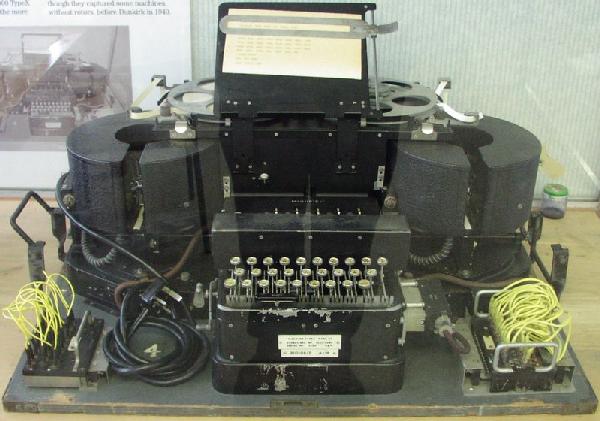 |
| Bletchley Park display: This is a post-war Typex Mk22 was
lovingly restored to functional order and with two types of plugboards.
The original plugboard jumper wiring was black, not yellow. This excellent
recreation using modern wires illustrates the plugboard wiring. A good
operator could do 40 wpm on the keyboard. (Bletchley Park photo
via Wikipedia) |
Typex Mk II used five active rotors plus one static rotor
(similar to the Enigma's umkerwalze or reflector). The two entrance rotors,
IV and V, were stators and, once initially set, did not move during encipherment.
With its three moving rotors, two stators, and a reflector, Typex was plainly
a copy of Enigma and infringed their patents. A long correspondence between
the Whitehall bureaucrats began as to who would have to pay royalties to
the Berlin factory. This was still going on when war began.
What Typex did not have was, of course, the stecker or
plugboard, because that had been added only to the military version
of Enigma and no one at GCCS had ever heard of this improved model. GCCS
had refused to cooperate with French and Polish codebreakers before the
war, and it was not until 25 July 1939 that members of GCCS visited the
Polish codebreaking center near Warsaw and for the first time saw their
copy of the German military Enigma. The Army took thirty machines from
the RAF order for field trials, most of which they left behind on the beaches
at Dunkirk in 1940. Fortunately the Germans saw they were copies of the
old commercial Enigma and simply took them into service, as they interfaced
without difficulty with their older Enigmas; and as they believed Enigma
was unbreakable, they made no attempt to see if Typex could be broken.
If properly used, the Enigma was unbreakable, and indeed several
keys were never penetrated by GCCS throughout World War II; but the machine
suffered from three basic problems. First, by the time World War II began
its hardware technology was already ten years out of date, so that, for
example, the most secure version used by the German Navy came with a set
of eight rotors, four of which were used at a time. But by 1941, the U.S.
Army's Sigaba cryptograph (called ECM by the U.S. Navy) used fifteen rotors,
ten to create the electrical maze and five for the mechanical linkage.
It was not until late into the war that the Germans introduced their ten
rotor Geheimschreiber cryptograph. The second problem with Enigma was the
software, particularly the initial keying procedure, which required a three
letter group to be repeated twice, and it was this flaw that enabled Polish
codebreakers to first enter the system. The third problem was that because
some 10,000 Enigmas were in use, they became so commonplace that bored
code clerks began taking shortcuts so that, for example, they would run
their fingers diagonally down the keyboard producing repetitive three letter
combinations like QAZ or WSX. All this was in addition to the fact that
the rigid hierarchical command structure of Germany's armed forces produced
endless stereotyped messages which were easily identifiable.
Although the history books have concentrated on showing how clever
the British and American codebreakers were at penetrating the German and
Japanese code systems, the truth is that the Royal Navy had just as insecure
codes as did the Japanese and for several years into the war suffered badly
from their refusal to accept modern cipher technology".
This directly quoted passage says "Typex Mks V, VI, and VII
were all experimental models and never went into production". With respect
to the Mk VI, this is incorrect. Rusbridger may have meant to say
"Mk IV, V and VII", which are marks which Ralph Erskine states, "may have
been experimental, or have had only limited production runs".
One other problem lies with the (omitted) direct quotation "The Royal
Navy refused to even experiment with Typex, let alone use it in their ships,
because it was beneath their dignity to use a machine designed by the RAF,
which they considered the junior service, and they were also highly displeased
that a junior officer like Mountbatten should have told them the Navy's
cipher security was no good".
Erskine argues convincingly that the view that the Royal Navy rejected
Typex is incorrect, and that the reason the Admiralty didn't put Typex
on board ships was due to slow production. Certainly, the (omitted)
statement that, "The Royal Navy refused to even experiment with Typex"
is incorrect. Erskine cites Archive files to show the Admiralty had ordered:
* 630 machines by October 1939
* Further orders by July 1941
* Sent Typex to 50 ships and 36 shore authorities.
* In December 1942, the Navy wanted to receive 500 machines by 1943.
(Of course, the CCM came into use in 1943 instead).
From 1943, the Americans and the British agreed upon a Combined Cipher
Machine (CCM). The British Typex and American ECM Mark II could be adapted
to become interoperable. While the British showed Typex to the Americans,
the Americans never permitted the British to see the ECM, which was a more
advanced design. Instead, attachments were built for both that allowed
them to read messages created on the other.
Erskine (2002) estimates that around 12,000 Typex machines had been
constructed by the end of World War II. Of these, about 8,200 were
Mark II machines and perhaps 3,000 Mark VI Typex devices were made before
August 1945.
Typex was used by the British armed forces and was also used in Commonwealth
countries such as Canada and New Zealand. They continued to remain in service
until the early 1970's.
ROTORS
From Wikipedia: "Another improvement the Typex had over
the standard German Services Enigma were the use of of multiple notched
rotors that would turn their neighbouring rotor.
Some Typex rotors came in two parts — a slug containing the wiring
was inserted into a metal casing. Different casings contained different
numbers of notches around the rim, such as 5, 7 or 9 notches. Each slug
could be inserted into a casing in two different ways by turning it over.
In use, all the rotors of the machine would use casings with the same number
of notches. Normally five slugs were chosen from a set of ten. On a Typex
rotor, each electrical contact was doubled to improve reliability".
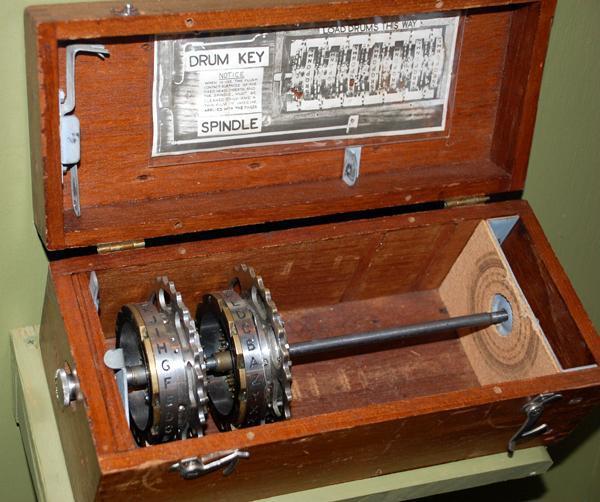 |
| Typex rotors on display at the Communications and Electronics Museum,
Kingston, Ontario. (Photo by Jerry Proc) |
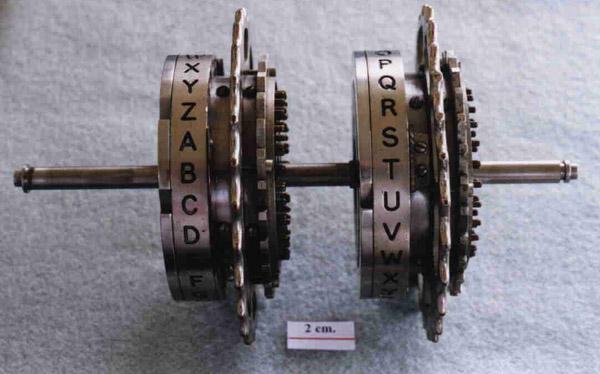 |
|
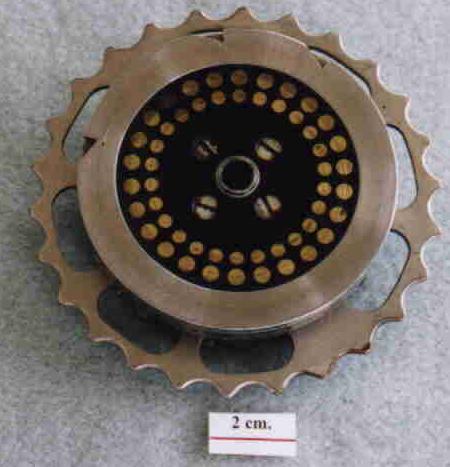 |
|
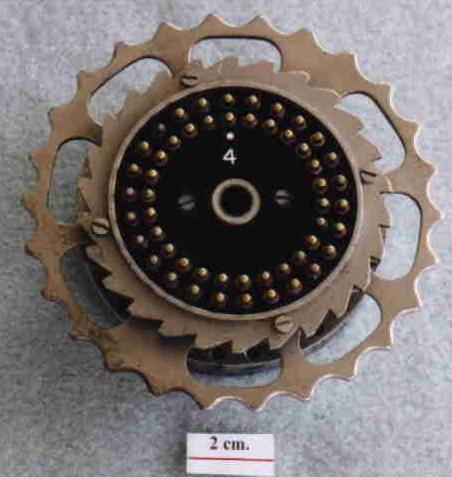 |
|
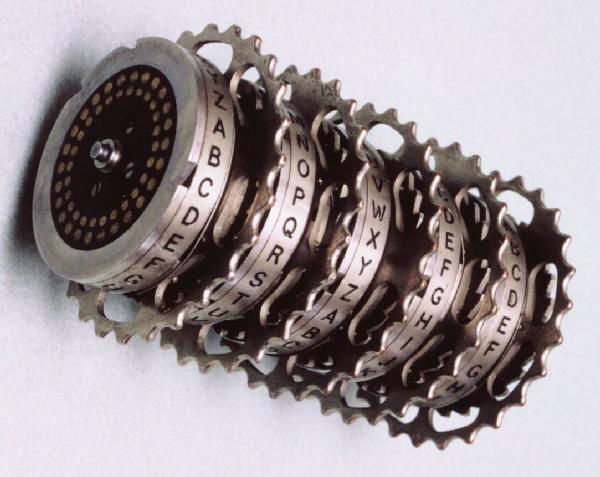 |
| This is a rather special set of test rotors that were used to check
the functions of newly built Typex machines. (Photos by David Hamer,
NCMF) |
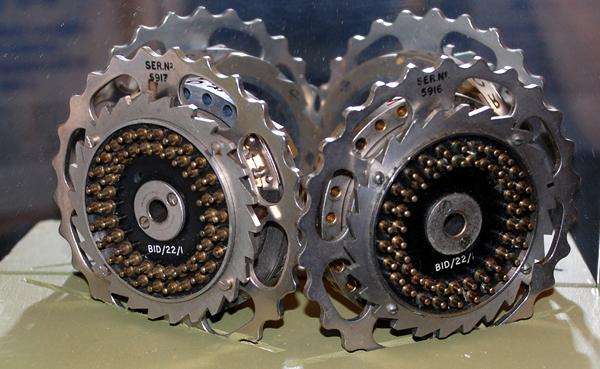 |
| Typex BID22 rotors. (Photo by Jerry Proc) |
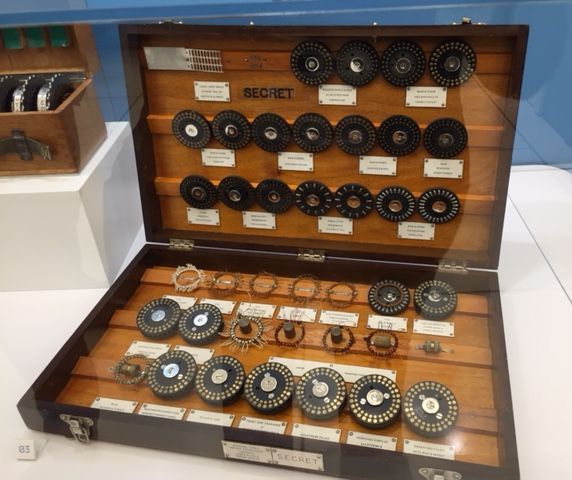 |
| Storage case for Typex rotors. (Photo
by Richard Brisson) |
SOME TYPEX VARIANTS AND DESIGNATORS
Sometimes Typex is written as TypeX . The initial machines
were called "Enigma type with X-attachment" . This was expressed as TypeX
then later as Typex.
Typex variants were assigned BID designations as : BID08/01
08/02 08/03 and 08/04
(Rockex was given a similar designations but higher in the series:
BID08/05 08/06 08/07 08/08)
As higher versions of the Typex were produced, the BID08 designators
were discontinued. Mark 22 was therefore designated BID 22 , Mk 23
became BID 23 etc.
Typex 22 and Typex 23 were later variants that incorporated
plugboards for improved security. The plugboards were located on either
side of the keyboard. Both the Mk 22 and Mk 23 types were essentially Mk
6's with modifications.
Mark 23 was a Mark 22 modified for use with the CCM. In New Zealand,
the Typex Mark 2 and Mark 3 were superseded by Mark 22 and Mark 23 on 1
January 1950.
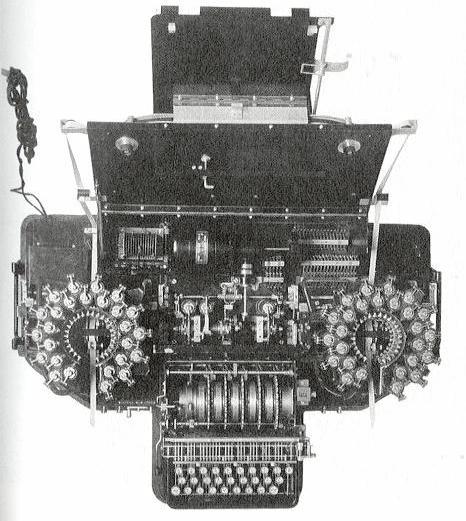 |
| Typex Mk II circa 1938. Based on the commercial Enigma design, the
machine could achieve 300 operations per minute. Each Typex cost the government
107 pounds back then. Note that each print drum has 26 print solenoids,
one for each letter of the alphabet. A switch on the front panel would
also allow the operator to switch from letters to figures. Replacing
a defective solenoid was a challenging task according to one Typex maintainer.
(Photo by James Rusbridger) |
 |
| Typex MkIII circa late 1930's. A message is typed with the
left hand while operating the handle with the right. The encrypted text
was printed on a paper tape. The machine had a maximum speed
of 60 operations per minute. (Photo 10305551. Science and Society
Picture Library) |
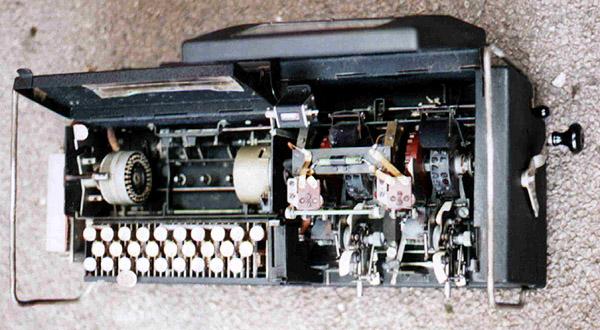 |
|
Typex Mk 6 (Photo source unknown)
|
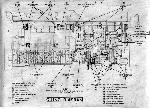 |
This is believed to be the oiling diagram
for the Typex Mk 6. Can anyone confirm? Click on image to enlarge.
It was common for maintainers to use Vaseline for Typex lubrication. (Image
submitted by John Kaesehagen, Adelaide Australia. <yendor3(at)bigpond.com>
) |
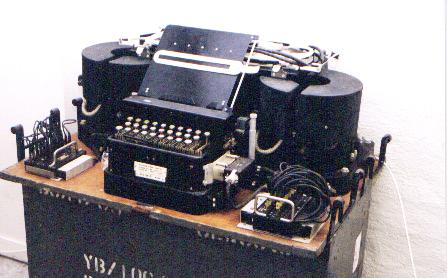 |
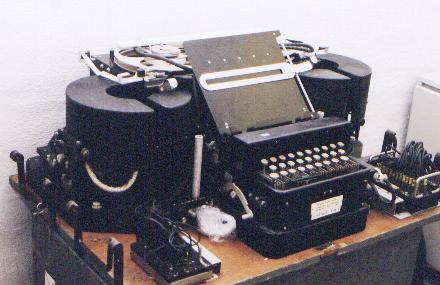 |
| This machine (Mk 22 or 23) is on display at the Forsvarsmuseet (Trandum
Annex) in Oslo, Norway. The Forsvarsmuseet is Norway's Armed Forces Museum
whose main facility is in the Akershus Fortress in Oslo, an operational
military base. The collection of cipher machines/radios/vehicles/etc. is
outside of the city in Trandum, adjacent to the Oslo airport at Gardermoen
about 40 or so km north. Admission to Trandum is by invitation only
with an escort required due to its still-active military status. (Photos
by David Hamer, NCMF) |
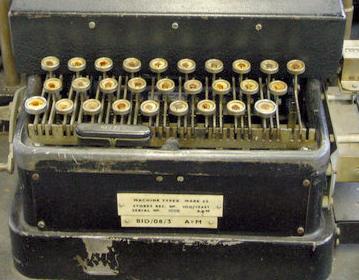 |
| This Mk 23 machine on display at Bletchley Park bears a nameplate
with an Air Ministry BID/08/03 designation. (Bletchley Park photo
via Wikipedia) |
MK III DESCRIPTION
Printing is by means of a wheel with the characters embossed
on the periphery, continuously inked by a roller and against which the
single strip of paper is pressed, hence there is no reference tape. The
mechanism revolves once for each key press, the wheel being raised for
upper case characters. Electrical power is produced by an impulse generator
at the beginning of each revolution, stored in a capacitor and released
when the appropriate character reaches the printing head to energize a
small relay which trips the printing head to press the paper momentarily
against the wheel. Because of this method of printing and the small amount
of power available, all adjustments are very critical.
PRINTING MODES
Cipher Mode : The left drum printed
the plain language version of what was typed while the right drum printed
the encrypted version By having a hardcopy of the plain text, it confirmed
that input was correctly entered.
Decipher Mode: It was opposite to that of cipher mode. The left drum
would print the cyphered text while the right drum would print the deciphered
message in plain text.
In other words, the left drum always printed the keyboard input while
the right drum printed the results of cypher or decipher modes.
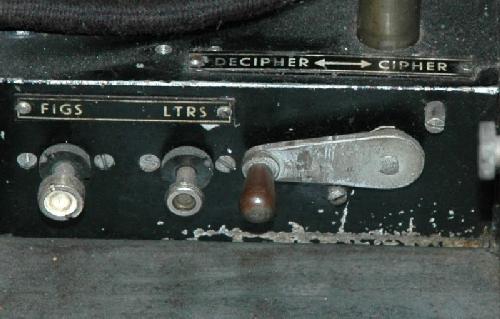 |
|
Typex controls. (Bletchley Park photo via Wikipedia)
|
OTHER OPERATIONS
This is an excerpt from Kruh and Deavours' Cryptologia article, "The
Typex Cryptograph" (1983):
The space bar and the "X" key are connected so that word divisions
are enciphered as X's. The Figures Shift is connected to the letter "Z"
while the Letters Shift is also "V". Thus, the letters "Z" and "V" are
entered via their shifted equivalents as visible on the keyboard while
these two letters indicate the requires[sic] shift functions in the text.
POWER
In locations where commercial AC power mains were not available,
Typex could be operated from a DC power by employing a rotary converter.
Any rotary converter consists of an AC or DC motor driving a generator
(DC output) or alternator (AC output).
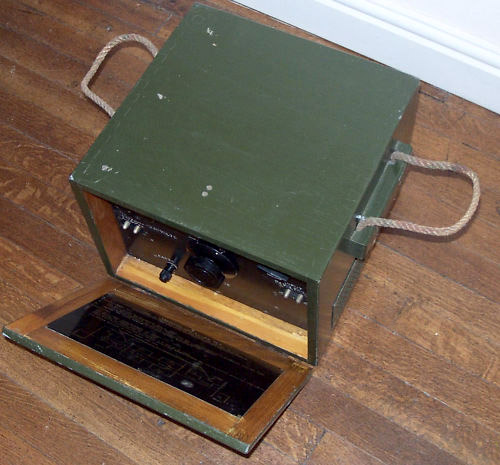 |
| The case dimensions are 14" x 14" x 11" and the
converter weighs 27 kgs. |
 |
| The converter was made by E.D.C.C. |
 |
| This rotary converter unit No.2 (DC to AC) allowed the Typex
to operate from 24 VDC power sources. Input : 24 VDC Output: 230
VAC; 50 Hz. 100VA. (Photos via E-bay) |
COMMENTS FROM TYPEX USERS
Mike Simpson, a former Typex operator, relates
some information. "At one time, our Washington office was located in a
National Security Agency building, so messages were encrypted in Typex
first, then typed up on 5-unit tape and re-encrypted in Rockex for transmission
to the UK. Such messages had to be UKEYESONLY to justify such encryption.
The rumour was that the Yanks could read the Rockex Tempest through the
wall.
One problem we had with the Typex was the sticky
tape the 5-letter code groups were typed on during encryption, or the plain
text during decryption. If the weather got very cold, the glue became very
brittle thus causing the paper to break".
**********
An ex-Royal Navy sailor sent this Typex anecdote. "During WWII,
I used the Typex many times and yes it had changeable rotors. Our instructions
were to destroy the machine if it was in danger of falling into enemy hands.
A heavy mallet was supplied with the machine. When Singapore fell to the
Japanese all the rotors from the machine at the signal station were packed
in a bag and taken to the evacuating ship. The machine itself was thrown
from the top of a four story building (easier than using a hammer) but
on examination all it had was a slight dent so it was ditched in the harbour".
**********
Bill Moffatt served in HMCS Iroquois in Korea in 1952. He recalls the
Typex. "The British machine that we had on the Iroquois was a TYPEX. I
recall that it had five the code wheels which I believe were much
larger than those used in the American KL-7 machine. The Typex was a slow,
clunky machine. I don't recall that we had anyone maintaining the
Typex but I believe we had to wipe the code wheels with some kind of an
oily cloth from time to time. The deciphered text was printed on a paper
tape which was then stuck unto a message form and sent to the Message Center
for typing and distribution. The classification levels that I recall were
Unclassified,
Restricted,
Secret
and Top Secret. They also had a priority classification.
As a 19 year old kid, just two years out of high school, I never
thought much about security. We had been instructed in Comm School about
the need to destroy the crypto machines and systems if we were about to
be captured or sunk but there were no specific instruction or drills on
the ship and I can't recall that security was ever mentioned. I don't believe
that any background checks were ever made on operators and we were not
warned not to discuss the machines or the cryptographic processes but we
never did. The machines were on desks in a small compartment used by the
ship's communicators but I don't recall any rules or signs barring access
to the compartment by other crew members. When not in use, the code books
and code wheels were kept locked in a safe in the compartment where the
machines were kept. I don't recall that I needed to go to anyone
else to get access to the safe. As I said, I didn't give it much thought
at the time, but I left the navy in 1955 and in later years it occurred
to me that there had been a very relaxed attitude about security during
my time in the navy. I felt that the navy took more security measures
in safeguarding the rum than with the crypto machines and codes.
We were taught the basics of book codes in Comm School but I don't
think I ever saw a crypto machine before I went on the Iroquois. I was
instructed in their use on the Iroquois by the yeoman who was a Chief Petty
Officer and by a LS Signalman who had been in the Royal Navy before coming
to Canada. After I left the Iroquois, I never used a crypto machine
again. On my return to Canada from Korea, I took a teletype course at Cornwallis
where I obtained a typing speed of 50 WPM. Subsequently, I was posted to
the Naval Radio Station at Albro Lake near Dartmouth where I worked on
teletype for the Canadian forces network".
**********
Fred Jones, a Royal Navy Petty Officer Radio Mechanic during WWII,
offers some background information on the Typex and one interesting experience
with it while serving in HMS Lookout. "The various Typex "Marks" were developed
over the years to cope with the German efforts to crack it's cyphering.
Several of the earlier machines were left behind at the evacuation of Dunkirk
by the R.A.F. These were found by the Germans, but since they were obviously
copies of the commercial Enigma, they didn't give them much attention.
The major difference, apart from giving a printout of both
plain-text and cipher text, was the requirement for an A.C. mains supply.
It was also very heavy. It used to take two strong Marines to lift
the beast off it's table and carry it to a secure area when we entered
harbour. Typex was, of course, on the SECRET list, so it was mandatory
to operate it behind a curtain in the Wireless Office. All messages
decrypted on the machine were sealed by the operator and delivered by hand
to the Captain. No one on board, except those authorized in writing from
the Captain, were allowed to even see the machine. When in
operation with the cover off, the Wireless Office remained locked.
I do remember an occasion where I was working on the Typex and there
was a rattling and banging on the Office door. I stood up and asked who
it was. " The Engineer Officer", was the reply. "Open this door,
immediately!" I went back to the coding table, locked up the
Typex, drew the curtain and then unlocked the door. The the Engineer Lieutenant
stood in the doorway fuming with anger. "How dare you lock this door?"
he snarled, trying to look past me into the Office. "What are you up to,
out of my way " as he tried to push past me. I stood in his way and
respectfully pointed out to him the notice on the door. "Have
you written authority from the Captain to enter this compartment?" I asked.
"Get out of my way " he said and tried to push past me into the Wireless
Office. In response to this action, I slammed the door shut in his
face, locked it and went back to my work. More thunderous knocking and
imprecations from outside the door, which I ignored... then silence.
After a few minutes the office phone rang. "This is the Captain speaking.
Why have you behaved disrespectfully to the Engineer Officer? He wants
to charge you with a court-martial offence". I pointed out to the Captain
that as the Engineer Officer did not have his written authority to enter
the Wireless Office, I was merely carrying out the King's Regulations (K.R.'s)
and Admiralty Instructions (A.I's) that were clearly written and affixed
to the door. Also, I mentioned that I was working on the Typex
machine at the time which the Engineer Officer was not authorized to see,
so it was the Engineer Officer who was actually in default and culpable
of a court-martial offence under the Official Secrets Act. A few more rumblings
from above, then it all died down. Though that Engineer would never
speak to me again, he was drafted to a shore base a few weeks later".
*********
Another technician who serviced Typex machines while he was a technician
with the Royal Air Force in the 1950's recalls the following. "They were
normally very good and most problems were with the plugboards. Often they
had been oiled, but one NEVER oils a Typex machine - it is lubricated
with Vaseline only. When being sent to an RAF station we always took
a spare Typex in our standard kit because it always took far too
long to find out what was wrong with the faulty machine on station. Normally
we gave them our spare and took the defective unit back to the service
depot.
After finding many faults with the double plugboard wiring , I would
test the machine by setting all the rotors to AAAAA and encypher
mode, then type the plain language message so that it came out on the left
hand drum in plain language, it should then come out in cypher on
the right hand drum. Then I would reset all rotors to AAAAA and then
switch to decypher, and then type the cypher message, which would then
come out on the left hand drum in cypher. If I had repaired it properly
it should come out in plain language on the right hand drum. If it
didn't then I had to strip the machine down again - very boring".
**********
Ray Fortin, a former technician with Foreign Affairs Canada,
also confirms that Typex plugboards were a maintainer's constant headache.
" I recall that the plugboards were the biggest problems. By 1970, those
wires on the plugboards had many years of wear and tear since the wires
were changed on a daily basis and if the communicator doing the changeover
would pull the wires by the middle instead of grabbing the connector body
to pull them from the socket, the old and brittle wire would break
or become intermittent. Vaseline was used on the rotor contacts.
**********
David Smith , a former communicator with Foreign Affairs Canada says
"If one was smart, they would clean the rotor contacts (both sides I believe),
and then apply a small film of vaseline to all the contacts. This ensured
the rotors would spin properly and seat well as well as making a good electrical
contact. While in the service of Canada's Foreign Communicators, the machine
acquired the sobriquet Iron Chinaman".
**********
From John Roy, former communicator with Foreign Affairs Canada."In
1962 I was posted to the UN force in the Congo and was informed that I,
along with a Sargent would be escorting new Typex rotor inserts. I remember
that on my crypto course, the instructor said how fragile they were.
Eventually Ron Holding (another External Affairs ex communicator) and I
were tasked to destroy some of the inserts. Believe me - the part about
the rotors being fragile was simply not true. We tried sledge hammers
and a piece of pipe with the sharpened ends and hammer and chisel, all
to no avail. At this rate the descruction of the inserts was going to turn
into a retirement project. In the end, we used a blow torch to melt
each rotor into an recognizable blob of bakelite and bits of wire.
Often wonder what the Congolese garbage man would have constructed out
of the pile rubbish that we threw out?".
And how's this for improvisation? - John Roy describes a quick
fix for Typex. "When we ran out of those springs used on the Typex tape
reels, we used the Army issue condoms instead of the springs.
A pair of scissors and a condom were kept close by. One a time,
a piece of the condom was cut off and slipped over over the spring
holders. The machine was placed in operation until the condom broke.
The process was repeated until we could obtain proper springs. Army
condoms were only slightly thinner than car inner tubes".
ADDITIONAL READING
1) The use of Typex in New Zealand, please select
this link. Refer to page 8.
2) Restoring the Typex Machines at
Bletchley Park.
Contributors and Credits:
1) Bill Moffatt. E-mail: bmoff(at)iname.com
2) David Smith <drdee(at)sympatico.ca>
3) Matt Russell <matt_crypto(at)yahoo.co.uk>
4) Wikipedia http://en.wikipedia.org/wiki/Typex#References
http://commons.wikimedia.org/wiki/Typex
5) Fred Jones <g2ivsenoj(at)tiscali.co.uk>
6) Ray White <r.p.white(at)sympatico.ca>
7) Appendix 8 of the book “Betrayal at Pearl
Harbor – How Churchill Lured Roosevelt into World War II” by James
Rusbridger and Captain Eric
Nave. ISBN 0-671-70805-8 © 1991 Published by Summit Books, a
subsidiary
of Simon & Schuster
Inc.
8) Science and Society
Picture Library - UK
http://www.scienceandsociety.co.uk/results.asp?image=10305551&wwwflag=2&imagepos=6
9) David Hamer, NCMF <dhhamer(at)comcast.net>
10) Raymond Fortin <raymondfortin(at)rogers.com>
11) John Roy <john.roy3(at)sympatico.ca>
12) David White <davidwhite400(at)hotmail.com>
13) John Kaesehagen <yendor3(at)bigpond.com>
14) Martin Gillow <martin(at)virtualcolossus.co.uk>
Back To Menu Page
Mar 18/20


















